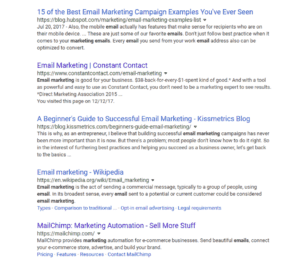
Karl Kangur, CEO, MRR Media
If you’re an e-commerce business owner and you don’t have a blog, you’ve probably wondered if creating one will grow your traffic and boost your sales.
In this article, we’ll explore why it is so important to add a blog with high-quality content to your e-commerce marketing mix. We’ll also examine ways you can measure the effectiveness of your blogging efforts.
Content Marketing and SEO
Did you know that consumer traffic arrives at e-commerce stores through four primary channels?
- Organic search
- Paid search
- Referrals/word of mouth
- Repeat customers
Organic traffic can be hard to come by, particularly if you have established competitors operating in the same niche. The best way to drive organic traffic is through content marketing and search engine optimization (SEO). There was a time when you could “stuff” your site with keywords and fool the search engines, like Google, into thinking you were creating valuable content. Those days are long gone. Google has gotten much smarter and better at sniffing out quality content.
Try this experiment. Google a “keyword” related to your business, and check out the search engine results page (SERP). Ignore the top few results—the ones marked as “Ads.” I’m guessing you already did. Those are the paid search results—and they can be very pricey indeed. If you’re like me, you routinely ignore these results and scroll down for the “real thing.”
And I’m not alone, 39% of online traffic is driven by organic search. That’s 58% higher than the next biggest source, paid search. Only 18% of traffic comes from users going directly to a site, and just 3% comes from email. Content suddenly seems much more important, doesn’t it?
Take, for example, this screenshot, using “email marketing” as the keyword:
 A quick perusal of the organic search results shows industry leaders Hubspot, MailChimp, Constant Contact, and Kissmetrics all in the top five. Click through to any one of those sites and take notice of their content. In this highly competitive market, each one of these companies clearly takes their content marketing very seriously. So seriously, that it is virtually impossible to write an article about email marketing without using one of the four companies as a reference.
A quick perusal of the organic search results shows industry leaders Hubspot, MailChimp, Constant Contact, and Kissmetrics all in the top five. Click through to any one of those sites and take notice of their content. In this highly competitive market, each one of these companies clearly takes their content marketing very seriously. So seriously, that it is virtually impossible to write an article about email marketing without using one of the four companies as a reference.
In the world of organic search, the once humble blog is now king.
Customer Engagement
Wouldn’t life as an e-commerce store owner be easier if everyone who visited your site just bought something? It surely would, but sadly that’s not how the world works. The global average sales conversion rate for 2017 was only 1.6%. The sad fact is that in all likelihood over 98% of your visitors won’t make a purchase. At least not the first time they visit.
Another metric to look at is how time spent on site relates to sales. By increasing user time on site by 16%, conversion rates ramp up 10%. This means “sticky” websites—ones that engage customers enough that they stick around—perform significantly better than ones that don’t. Creating relevant and engaging content is one of the best ways to get sticky.
Branding and Social Media
One of the best ways an e-commerce store can differentiate itself from competitors and earn customer loyalty and trust is through branding. Nowhere do you have more control of how your brand is perceived than on your own site. Think of your site (and blog) as your own little corner of the internet. As long as users stay on your site, you have the opportunity to tell them your story and build a connection with your brand.
Another channel where a blog creates value is social media. Having a social media strategy is now considered a virtual necessity for any successful e-commerce business. What better to post on Facebook or Tweet about than your own content? Not only can this drive visitors to your site, creating and sharing valuable content via social media can do wonders for your branding efforts.
Measuring Results
If you’re still not convinced that blogging is viable for your e-commerce store, put it to the test. Every online business owner should be using Google Analytics to measure their site’s performance. If you’re not, how will you know where your traffic comes from and how to improve it? Google Analytics even allows you to measure how first-time and repeat visitors interact with your site as well as how much time they spend on it.
Conclusion
Blogging is not only viable for your e-commerce business—it’s practically mandatory if you want to outpace your competitors. Implementing a solid content marketing strategy and creating relevant blog posts takes time. But there are tools out there that can help. Postach.io is a fantastic free tool that combines with Evernote to make blogging a breeze.
Although content marketing is all about regular publishing and volume, it’s only important for getting results faster. You don’t have to invest in a full-time content writer and publish things weekly to get results.
Start off slowly and aim to publish at least one high-quality post per month. Observe the results you get from that and you’ll quickly see that it’s a no-brainer investment for your 2018 marketing strategy.
MRR Media provides such services for online businesses as content creation, outreach marketing, social media management, email marketing and ad management.
Favorite
